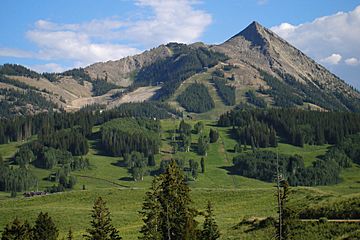Crested Butte facts for kids
Quick facts for kids Crested Butte |
|
|---|---|

Crested Butte from the north
|
|
| Highest point | |
| Elevation | 12,168 ft (3,709 m) |
| Prominence | 2,582 ft (787 m) |
| Isolation | 4.65 mi (7.48 km) |
| Listing | Colorado prominent summits |
| Geography | |
| Location | Gunnison County, Colorado, U.S. |
| Parent range | Elk Mountains |
| Topo map | USGS 7.5' topographic map Gothic, Colorado |
| Climbing | |
| Easiest route | hike |
Crested Butte is a famous mountain peak in the Elk Mountains. This mountain range is part of the larger Rocky Mountains in North America.
The top of Crested Butte is about 12,168 feet (3,709 meters) high. It is located in the Gunnison National Forest in Colorado, United States. The mountain is about 3.4 kilometers (2.1 miles) northeast of the Town of Crested Butte. On the north side of the mountain, you'll find ski lifts and runs for the Crested Butte Mountain Resort.
Contents
What is the Climate Like on Crested Butte?
The climate around Crested Butte is called "continental subarctic." This means it has very long, cold winters. During winter, there are fewer hours of daylight, lots of snow, and the air is very dry.
How Much Snow Does Crested Butte Get?
On average, Crested Butte gets about 198.4 inches (504 cm) of snow each year. January is usually the snowiest month, with an average of 40 inches (102 cm) of snow.
What are the Temperatures Like?
July is the warmest month, with an average temperature of 57.2°F (14.0°C). January is the coldest month, with an average temperature of 11.8°F (-11.2°C). The average temperature for the whole year is about 34.7°F (1.5°C).
How Was Crested Butte Formed?
Crested Butte is a special type of mountain called a laccolith. This means it formed when hot, melted rock, called magma, pushed its way up into softer layers of rock about 30 million years ago.
What is a Laccolith?
Imagine a balloon inflating under a blanket. The magma pushed up the layers of rock above it, but it didn't break through to the surface. Over millions of years, the softer rock on top slowly wore away. This process, called erosion, exposed the harder, volcanic rock that makes up Crested Butte today.
What is Crested Butte Made Of?
Most of Crested Butte is made of strong, hard rocks like quartz monzonite and granodiorite. These are types of igneous rock, which means they formed from cooled magma. The lower parts of the mountain are made of a softer rock called Mancos Shale. This shale can sometimes be unstable, which might lead to landslides or earthflows (slow-moving slides of wet soil).
Are There Other Mountains Like Crested Butte?
Yes, Crested Butte is one of many laccoliths in the Elk and nearby West Elk Mountains. When the magma pushed into the ground to form these mountains, it also changed the surrounding rocks. This process is called metamorphism. It also created valuable minerals. The heat from the magma even turned regular bituminous coal into a higher quality coal, like anthracite. This type of coal was mined a lot in the Crested Butte area in the late 1800s and early 1900s.
Gallery
See also
 In Spanish: Crested Butte para niños
In Spanish: Crested Butte para niños




